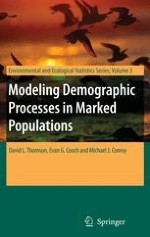2009 | OriginalPaper | Buchkapitel
Contribution of Capture-Mark-Recapture Modeling to Studies of Evolution by Natural Selection
verfasst von : Emmanuelle Cam
Erschienen in: Modeling Demographic Processes In Marked Populations
Verlag: Springer US
Aktivieren Sie unsere intelligente Suche, um passende Fachinhalte oder Patente zu finden.
Wählen Sie Textabschnitte aus um mit Künstlicher Intelligenz passenden Patente zu finden. powered by
Markieren Sie Textabschnitte, um KI-gestützt weitere passende Inhalte zu finden. powered by
